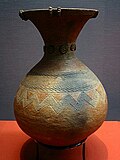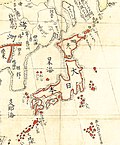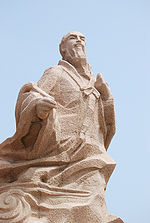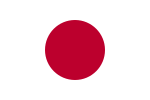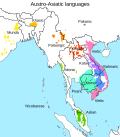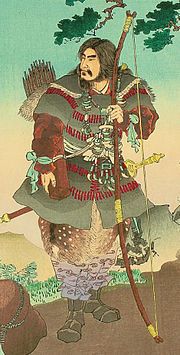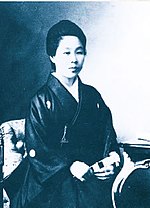The Yayoi people (弥生人, Yayoi jin) were an ancient people that immigrated to the Japanese archipelago during the Yayoi period (300 BC–300 AD) and are characterized...
14 KB (1,592 words) - 07:25, 5 November 2024
The Yayoi period (弥生時代, Yayoi jidai) started in the late Neolithic period in Japan, continued through the Bronze Age, and towards its end crossed into...
28 KB (2,925 words) - 17:38, 23 October 2024
Yamato people represent an ethnic assimilation of the Jomon people, who lived in the Japanese archipelago since early times, and the Yayoi people, who migrated...
42 KB (4,665 words) - 22:30, 19 November 2024
those of Jōmon people and northwestern Kyushu Yayoi people, and some groups on the plain also resembled northern Kyushu Yayoi people. Additionally, skeletons...
14 KB (1,887 words) - 23:08, 20 July 2024
Yayoi Kusama (草間 彌生, Kusama Yayoi, born 22 March 1929) is a Japanese contemporary artist who works primarily in sculpture and installation, and is also...
106 KB (10,876 words) - 16:24, 12 November 2024
origins of modern Japanese people. From the point of view of genetic studies, Japanese people: mainly descended from the Yayoi people, the heterogeneous Jōmon...
40 KB (3,957 words) - 23:54, 1 October 2024
Wajin (倭人, Wajin, literally "Wa people") is in the narrow sense, the old name of the ethnic group of the Yayoi people who lived in the Japanese archipelago...
7 KB (1,097 words) - 17:24, 13 September 2024
300 BC, the Yayoi people originating from Northeast Asia entered the Japanese islands and displaced or intermingled with the Jōmon. The Yayoi brought wet-rice...
47 KB (4,090 words) - 06:00, 20 November 2024
the southern Jōmon (16,000–3,000 years ago) hunter-gatherers than the Yayoi people, who had rice farming culture, have smaller genetic contributions from...
96 KB (11,005 words) - 02:06, 19 November 2024
people who are of Chinese descent is unclear. It is believed that a substantial component of the Yayoi people migrated from China to Japan. The Yayoi...
43 KB (4,742 words) - 08:27, 6 October 2024
Japonic-speaking Early Jōmon people must have been drawn in to avail themselves of the pickings of Yayoi agricultural yields, and the Yayoi may have prospered and...
53 KB (5,782 words) - 19:56, 11 November 2024
History of Japan (section Yayoi period)
Book of Han in the first century AD. Around the 3rd century BC, the Yayoi people from the continent immigrated to the Japanese archipelago and introduced...
137 KB (16,278 words) - 12:17, 15 November 2024
female given name Yayoi Kusama, a Japanese artist and writer Yayoi people, an ancient ethnic group Yayoi, Ōita, a town in Japan Yayoi, Tokyo, an area of...
473 bytes (95 words) - 18:34, 14 February 2024
Jōmon period (category Ancient peoples)
Japonic-speaking Early Jōmon people must have been drawn in to avail themselves of the pickings of Yayoi agricultural yields, and the Yayoi may have prospered and...
53 KB (5,972 words) - 13:11, 21 November 2024
Xu Fu (category 3rd-century BC Chinese people)
the Paleolithic. The Yayoi people are thought to have migrated from Northeast Asia (likely from Korea) to Japan much later. The Yayoi period is generally...
11 KB (1,299 words) - 04:47, 17 November 2024
The Japonic-speaking Yayoi people entered the archipelago from the Korean Peninsula, intermingling with the Jōmon; the Yayoi period saw the introduction...
201 KB (16,457 words) - 15:53, 19 November 2024
arrivals of people from the East Eurasian continent, known as the Yayoi people. Japan's indigenous culture originates primarily from the Yayoi people who settled...
75 KB (7,798 words) - 15:38, 19 November 2024
others, such as tooth ablation, persisted into the Yayoi period. As with the Jomon people, the Yayoi people left behind a distinctive material culture of their...
28 KB (3,365 words) - 04:39, 16 August 2024
Austroasiatic paternal lineage and O1b2 the “para-Austroasiatic” lineage of the Yayoi people. According to Chaubey et al., "Austro-Asiatic speakers in India today...
11 KB (1,097 words) - 20:16, 5 September 2024
Japanese art (redirect from Yayoi art)
immigrants was the Yayoi people, named for the district in Tokyo where remnants of their settlements first were found. These people, arriving in Japan...
108 KB (14,063 words) - 22:10, 17 September 2024
300 to 538 AD (the date of the introduction of Buddhism), following the Yayoi period. The Kofun and the subsequent Asuka periods are sometimes collectively...
46 KB (5,478 words) - 20:21, 1 November 2024
Ainu spirituality. About 2,000 years ago, the island was colonized by Yayoi people, and much of the island's population shifted away from hunting and gathering...
140 KB (7,532 words) - 14:31, 21 November 2024
begins around 6000 BCE. Beginning around 300 BC, the Japonic-speaking Yayoi people from the Korean Peninsula entered the Japanese islands and displaced...
167 KB (15,389 words) - 03:41, 18 November 2024
Austroasiatic languages (redirect from Austro-Asiatic people of India)
lineage and O1b2 the "para-Austroasiatic" lineage of the Koreans and Yayoi people. A full genomic study by Lipson et al. (2018) identified a characteristic...
62 KB (5,897 words) - 10:17, 30 October 2024
Emperor Jimmu (category People of Jōmon-period Japan)
reflect a time when the Yayoi people from continental Asia immigrated in masses starting from Kyushu and moving eastward during the Yayoi period. Some scholars...
30 KB (3,969 words) - 18:08, 7 November 2024
Emperor Kōrei (category People of Yayoi-period Japan)
traditionally accepted as the first emperor of the Yayoi period, which is named after the Yayoi people who migrated to the Japanese archipelago from mainland...
14 KB (2,369 words) - 14:34, 12 July 2024
Yayoi (やよい, ヤヨイ) is a feminine Japanese given name. Yayoi can be written using different kanji characters and can mean: 弥生, "March" as a given name 彌生...
3 KB (368 words) - 20:02, 13 June 2023
Japan around the time of the Three Kingdoms period.[citation needed] The Yayoi people primarily lived on the island of Kyushu to the Kanto region on Honshu...
44 KB (4,576 words) - 17:26, 13 October 2024
Koreans in Japan (redirect from Korean people in Japan)
debated (see Origin of the Yayoi people). In the later Kofun (250–538 CE) and Asuka (538–710 CE) periods, there was some flow of people from the Korean Peninsula...
93 KB (10,226 words) - 09:59, 11 November 2024
intelligible with Japanese, nor with each other for the most part. When the Yayoi people migrated to the Japanese archipelago from Korea, they likely brought...
10 KB (1,091 words) - 04:28, 27 October 2023


